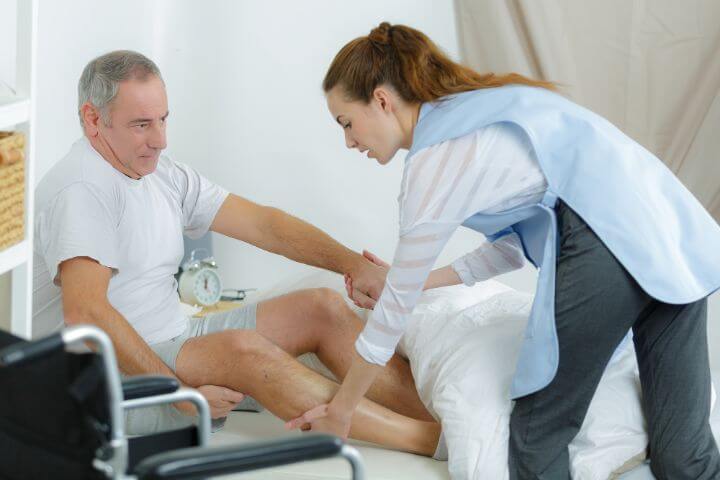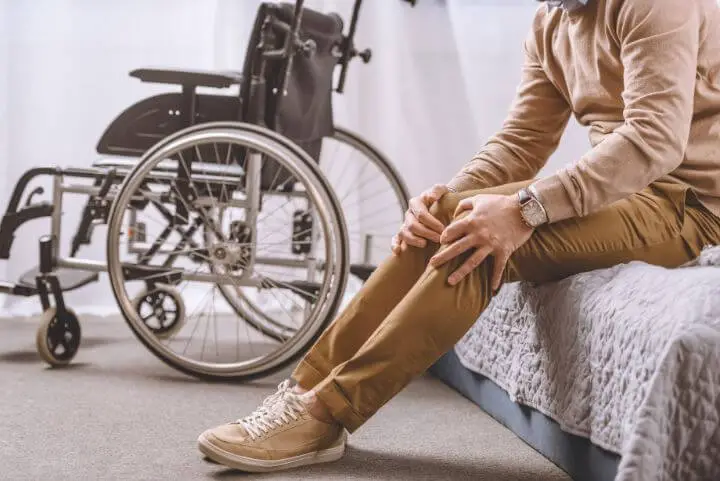Sometimes taking care of a loved one who is paralyzed can be both emotionally and physical demanding.
Depending on your own physical abilities, meeting the demands of a loved who needs help lifting, turning on other side and even transferring from the bed to a wheelchair could leave you injured – even if you think you know how to do it.
And if you are taking care of a paraplegic person, extreme care needs to be taken while lifting the patient, lest you injure them or yourself.
Contents
Common Injuries to Caregivers of Paraplegics
For those who are frequently moving and lifting a family member who is paralyzed they can be prone to certain injuries.
The most common injuries that at-home caregivers experience are around the back, neck, and shoulders.
These injuries often occur due to the overuse of the muscles in these areas. The repetitive motions of lifting and pulling – over and over – is the main cause of these injuries.
At-home caregivers can be at a higher risk for injuries at certain times, including
- Leaning over a person for a long period of time (cleaning them up, changing clothing, sponge bathing, etc)
- Moving a person who is reclining in bed into a sitting position
- Transferring someone from a bed to a wheelchair.
By making sure caregivers are using the proper techniques for lifting and transferring a paraplegic injury can very easily be prevented.
There are a few scenarios where your loved one may need to be moved or transferred positions, and there are safe ways to do this and keep everyone injury-free.
You might also like Best Bath Lifts For The Elderly and the Disabled
General Lifting Techniques
Whether you’re helping lift your loved one from their bed to their wheelchair, or from a bathing tub back to a chair, there are certain general techniques you can follow to make sure you stay injury free and you’re properly lifting your loved one.
- Your head, neck and back should be as straight as possible as this will keep all three of these areas of your body in proper alignment, and that will help avoid injury.
- Ever heard to lift with your knees, not your back? This applies here, too. Make sure you bend with your hips and your knees, and keep the natural curve of your spine. This will help avoid injuries to your back.
- Try to avoid twisting while moving or carrying your loved one. If you need to turn, turn with your whole body instead of twisting around.
- Keep the person being carried as close to your body as you can – the further away they are from your body, the heavier they will be and will likely cause you an injury.
- To help maintain your balance, keep your feet shoulder-width apart. This will help make sure you don’t trip or lose balance and drop your loved one or hurt them (or yourself).
- Use your leg muscles to lift – your legs have some big muscles in them, and they will be a great asset to you when transferring or lifting your loved one.
ProTip – if your loved one is being uncooperative, is too heavy for you or is just in an awkward position then you may want to consider asking a second person for help to safely transfer them.
Helping a Paraplegic Sit Up in Bed
Every person will have different physical abilities. Some paraplegics will be able to help themselves sit up in bed while others can’t do it.
If your loved one doesn’t have the upper body strength to push themselves up into a sitting position then you are likely going to have to help them a bit.
To do this, place one of your arms under their legs and your other arm behind their back. Next, move their legs over the edge of the bed while, at the same time, making sure you pivot their body so that your loved one ends up sitting on the edge of the bed.
Before you start, make sure your feet are shoulder-width apart. This will help you maintain your balance. Ensure that your knees are bent slightly while keeping your back straight and natural, not too rigid.
You might also like Best Stair Chair Lift For Seniors
Helping a Paraplegic to Stand Up
Your loved one may need help standing up so that they can be transferred to a wheelchair or from the bed to another piece of furniture.
The first step to this is to help the paraplegic patient sit up. Once you have the person in a sitting position (at the side of the bed) you are ready to help them stand up.
Position their feet slightly apart and flat on the floor. Next, face the person and you can either place their hands on the bed or on your shoulders to help them stand up – either is ok and it’s mostly just personal preference.
In many cases, nurses, physical therapists and other healthcare professionals working in medical facilities or hospitals will use a belt that is fastened around the waist of the person who is paraplegic.
This gives the person who is doing the lifting some extra help in lifting another person, and can give them some extra help so they don’t hurt themselves or drop the person midway through. Individuals can also purchase these assistive devices such as hoyer lift for helping to lift a loved one while you’re at home and do not have professional help all the time.
Moving From Standing to Sitting
Whether you’re moving your loved one from the bed to the wheelchair or another chair or even helping them get to the bathroom, you will need to help move them from a standing position (once you have them standing up) to a sitting position.
Once you have helped your loved on stand up, you will want to pivot your loved one towards the wheelchair (or where ever they are going to be sitting). Next bend your knees, with your arms still supporting your loved one and start to slowly lower them into the chair. It’s very important that you make sure the person has both hands securely on the arms of the chair before you start to lower them into the chair.
You might also like Best Swimming Pool Lifts for Elderly
Tips for Avoiding Injury
Even though you are used to moving your loved one daily, and helping them with all their needs there are still many ways you can injure yourself – even in a split second without meaning to.
There are a few ways you can avoid injury and make sure both you and your loved one stay healthy and strong.
Regular Exercise
You may be exhausted from the daily care of your loved one, trying to fit in regular exercise can be really beneficial. Exercise helps to build your muscles, which will in turn help with the lifting techniques.
Not only will you build your muscles and get stronger, exercising can really help with flexibility and that will also make it easier for transferring and lifting your loved one.
Teamwork and Communication
Even if you are the only one providing the lifting of your loved one, you still need to communicate with the person you are moving.
He or she may not be totally aware of what’s going on but communicating with them what you’re doing and if you need them to do anything or move a certain way (if they can). By communicating what you’re doing, and what you need them to do, you can definitely avoid injury.
You might also like Life as a Paraplegic: How to Adapt Your Daily Routine
Clear the Area
In an ideal world, the area around you would be completely clear of any tripping hazards but around our homes we all know that things just don’t work that way. Before starting to move your loved one, take the time to make sure the area you need to move around in is cleared and there is nothing that you can trip over.
Motivate Your Loved One
Sometimes, being paraplegic will leave your loved one feeling depressed and like they don’t want to do anything or even get out of bed. If they don’t want to move or do anything it can cause some extra injury because they aren’t motivated to help themselves.
Maybe your loved one enjoys being outside or having coffee with friends – whatever their reason for being motivated is, you can use this to help get them involved in helping themselves. Find out what that motivation is and communicate it with them so they can get excited about it.
You might also like Car Transfer Assistive Devices
Assistive Devices for Lifting
There are many devices designed for helping caregivers to lift their patients and loved ones, especially for those caregivers who may be physically smaller than the loved ones they need to assist.
If your loved one was in a hospital or care facility for any length of time, you may have noticed the medical staff using devices to help transfer them from place to place, but many of these devices are far too big (and probably expensive) for people to bring into their homes. Most homes would not have the space required for using one of these lift assistive devices so those who are caregivers at home may need something different to help them in their everyday needs.
There are gait belts that can be purchased to help you move your loved one safely and securely. If you have concerns about providing the right type of care, and safe transfer for your loved one, you can meet with their doctor or get a referral to a physical therapist to see how they can help you at home.
Your loved one, who is paraplegic, cannot always help themselves in ways they want to and maybe relying on you for some extra help. With a little forethought and preparation, you can definitely help your loved one to move around and transfer from bed to chair, and back again without injury!




